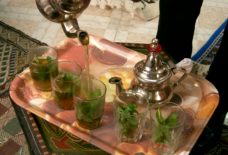Nothing is More Comforting than Steamy Hot Soup, Especially This Traditional Moroccan Bowl
SOURCE: THE BOSTON GLOBE
BY: SHERYL JULIAN
Harira, made with chickpeas, lentils, and rice or vermicelli noodles, is a nourishing dinner
Harira (Moroccan Chickpea-Lentil Soup)ED ANDERSON AND GEORGE DOLESEEvery week, there’s a fresh pot of soup simmering on a back burner on my stove. At first, there seems to be enough to feed an army. But as the week wears on, there’s less and less, so I add to it. I slip in oddments that other cooks would store in plastic containers in the back of the fridge and find a fortnight later in rough shape — a few roasted vegetables, some sauteed mushrooms, a spoonful of pasta, bits from the bottom of the salad bowl (yes, the greens go right in, vinaigrette and all). All of this fills the diminishing pot, and the soup is both replenished and reinvented on the fly.
Learn to make a nourishing, comforting pot of soup that will serve your family for several nights and and you can cut your food budget dramatically. Soup is a culinary phenomenon. It’s inexpensive to make, can be reheated repeatedly, and only gets better. If there isn’t space in your fridge, set containers of soup outside in a secure spot (don’t tempt the neighborhood critters) when the temperature is above freezing, but not below 40 degrees.
One of the soups in my regular rotation is harira, a Moroccan bowl of chickpeas and lentils with rice or vermicelli noodles. It’s a soup that’s often served at the end of the day to break the Ramadan fast. Sephardic Jews in Morocco break the Yom Kippur fast with harira. Both communities serve it year-round.
There are several steps to a good harira, which probably has as many variations as cooks who make it. The recipe in “The Chicken Soup Manifesto,” by Jenn Louis, a former Portland, Ore., restaurateur, begins by soaking dried chickpeas overnight. The next day you poach a small cut-up chicken to make the broth. (Later, the meat will be pulled from the bones to enrich the soup). Root vegetables get a start in a bit of chicken fat or oil, with cumin, both ground and seed, coriander, and turmeric. Legumes are added in stages. The soaked chickpeas go in next, along with saffron, and when they’re halfway cooked, lentils and rice are added. Finally, stir in the shredded chicken, and watch the pot become thick and stewy.
Aside from the generous spices, it’s an interesting soup, not quite remarkable. Then you add the juice of a whole lemon (maybe two), and handfuls of fresh cilantro and parsley, and suddenly you have something exceptional. Louis instructs you to chop the stems with the leaves, which is probably how every cook in Morocco does it. You’d be surprised how much flavor stems add to the pot.
Taste the broth to see if it needs more lemon. Writes Louis, “Squeeze in enough lemon juice to add as much tangy flavor as possible without it becoming sour.” She says that classic accompaniments are fermented butter, called smen, along with plain thick yogurt, and flatbread.
Instead of chicken, you can simmer harira with lamb or beef. You can add chiles, red lentils in place of brown, ground cinnamon or cinnamon stick, or fresh ginger. Some cooks thicken the broth with a flour paste, others with egg and lemon juice (like Greek avgolemono). Louis lets the meat and legumes thicken the broth.
It’s a bit of a project, but you’ll get something magnificent: a wholesome, nutritious, filling soup that you’ll enjoy making and eating.


